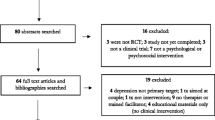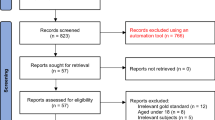Abstract
Objectives To examine associations between depression and preterm birth and small-for gestational age (SGA) among women of predominantly Puerto Rican descent, a population who experiences disparities in adverse birth outcomes and one of the highest infant mortality rates in the United States. Methods Proyecto Buena Salud (PBS) was a prospective cohort study conducted from 2006 to 2011 at a large tertiary care center in Western Massachusetts. Caribbean Islander (i.e., Puerto Rican and Dominican Republic) women were interviewed in early, mid and late pregnancy. Among 1262 participants, associations between depression, assessed using the Edinburgh Postnatal Depression Scale, and risk of preterm birth and small-for-gestational age (SGA) were evaluated. Results Women with at least probable minor depression [odds ratio (OR) = 1.77 (95% confidence interval (CI) = 1.02, 3.07)] or probable major depression [OR = 1.82 (95% CI = 1.01, 3.25)] in mid-pregnancy had an increased risk of SGA compared to non-depressed women in adjusted analyses. Borderline significant associations were observed between increasing levels of depressive symptom scores in early and mid-pregnancy [OR = 1.05 (95% CI = 1.00, 1.11) and OR = 1.04 (95% CI = 1.00, 1.09), respectively] and each additional trimester of exposure to probable major depression across mid- to late pregnancy [OR = 1.66 (95% CI = 1.00, 2.74)] and SGA. Late pregnancy depression was not associated with SGA; depression during pregnancy was not associated with preterm birth. Conclusions for Practice In this population of predominantly Puerto Rican women, mid-pregnancy depression increased risk for SGA. Findings can inform culturally appropriate, targeted interventions to identify and treat pregnant women with depression.
Similar content being viewed by others
References
Alegria, M., Mulvaney Day, N., Torres, M., Polo, A., Cao, Z., & Canino, G. (2007). Prevalence of psychiatric disorders across Latino subgroups in the United States. American Journal of Public Health, 97(1), 68–75.
Alexander, G. R., Kogan, M. D., & Himes, J. H. (1999). 1994–1996 U.S. singleton birth weight percentiles for gestational age by race, Hispanic origin, and gender. Maternal and Child Health Journal, 3(4), 225–231.
Bados, A., Gómez-Benito, J., & Balaguer, G. (2010). The state-trait anxiety inventory, trait version: Does it really measure anxiety? Journal of Personality Assessment, 92(6), 560–567.
Chasan-Taber, L., Fortner, R., Gollenberg, A., Buonnaccorsi, J., Dole, N., & Markenson, G. (2010). A prospective cohort study of modifiable risk factors for gestational diabetes among Hispanic women: Design and baseline characteristics. Journal of Women’s Health, 19(1), 117–124.
Chen, Y., Holzman, C., Chung, H., Senagore, P., Talge, N., & Siler Khodr, T. (2010). Levels of maternal serum corticotropin-releasing hormone (CRH) at midpregnancy in relation to maternal characteristics. Psychoneuroendocrinology, 35(6), 820–832.
Colby, S., & Ortman, J. (2015). Projections of the size and composition of the U.S. population: 2014 to 2060. U.S. Census Bureau. Retrieved from https://www.census.gov/content/dam/Census/library/publications/2015/demo/p25-1143.pdf. Accessed 27 Aug 2016.
Cox, J. L., Holden, J. M., Sagovsky, R. (1987). Detection of postnatal depression. Development of the 10-item Edinburgh postnatal depression scale. British Journal of Psychiatry, 150, 782–786.
Dole, N., Savitz, D. A., Hertz Picciotto, I., Siega Riz, A. M., McMahon, M. J., & Buekens, P. (2003). Maternal stress and preterm birth. American Journal of Epidemiology, 157(1), 14–24.
Evans, J., Heron, J., Patel, R., & Wiles, N. (2007). Depressive symptoms during pregnancy and low birth weight at term: Longitudinal study. British Journal of Psychiatry, 191, 84–85.
Field, T., Diego, M., & Hernandez Reif, M. (2006). Prenatal depression effects on the fetus and newborn: A review. Infant Behavior and Development, 29(3), 445–455.
Field, T., Diego, M., Hernandez-Reif, M., et al. (2002). Prenatal depression effects on the foetus and neonate in different ethnic and socio-economic status groups. Journal of Reproductive and Infant Psychology, 20(3), 149–157.
Garcia-Esteve, L., Ascaso, C., Ojuel, J., & Navarro, P. (2003). Validation of the Edinburgh postnatal depression scale (EPDS) in Spanish mothers. Journal of Affective Disorders, 75(1), 71–76.
Gibson, J., McKenzie McHarg, K., Shakespeare, J., Price, J., & Gray, R. (2009). A systematic review of studies validating the Edinburgh postnatal depression scale in antepartum and postpartum women. Acta Psychiatrica Scandinavia, 119(5), 350–364.
Glynn, L., Schetter, C., Chicz DeMet, A., Hobel, C., & Sandman, C. (2007). Ethnic differences in adrenocorticotropic hormone, cortisol and corticotropin-releasing hormone during pregnancy. Peptides, 28(6), 1155–1161.
Goldenberg, R., Culhane, J., Iams, J., & Romero, R. (2008). Epidemiology and causes of preterm birth. Lancet, 371(9606), 75–84.
Grote, N., Bridge, J., Gavin, A., Melville, J., Iyengar, S., & Katon, W. (2010). A meta-analysis of depression during pregnancy and the risk of preterm birth, low birth weight, and intrauterine growth restriction. Archives of General Psychiatry, 67(10), 1012–1024.
Hoffman, S., & Hatch, M. C. (2000). Depressive symptomatology during pregnancy: Evidence for an association with decreased fetal growth in pregnancies of lower social class women. Health Psychology, 19(6), 535–543.
Institute of Medicine Committee to Study Outreach for Prenatal Care. (1988). Who obtains sufficient prenatal care? In SS Brown (Ed.), Prenatal care (pp. 26–53). Washington, DC: National Academies Press.
Kim, D. R., Sockol, L. E., Sammel, M. D., Kelly, C., Moseley, M., & Epperson, C. N. (2013). Elevated risk of adverse obstetric outcomes in pregnant women with depression. Archives of Women’s Mental Health, 16(6), 475–482.
MacDorman, M. (2011). Race and ethnic disparities in fetal mortality, preterm birth, and infant mortality in the United States: An overview. Seminars in Perinatology, 35(4), 200–208.
Marcus, S., Flynn, H., Blow, F., & Barry, K. (2003). Depressive symptoms among pregnant women screened in obstetrics settings. Journal of Women’s Health, 12(4), 373–380.
Martin J, Hamilton B, Ventura S, Osterman MJK, Mathews TJ. (2013). Births: Final data for 2011. National Vital Statistics Reports, 62(1):1–69, 72.
Matthews, T. J., & MacDorman, M. (2013). Infant mortality statistics from the 2010 period linked birth/infant death data set.. National Vital Statistics Reports, 62(8), 1–26.
Matthey, S., Henshaw, C., Elliott, S., & Barnett, B. (2006). Variability in use of cut-off scores and formats on the Edinburgh postnatal depression scale: Implications for clinical and research practice. Archives of Women’s Mental Health, 9(6), 309–315.
McCowan, L., & Horgan, R. (2009). Risk factors for small for gestational age infants. Best Practice and Research Clinical Obstetrics and Gynaecology, 23(6), 779–793.
Motel S, & Patten E. (2012). Hispanics of Puerto Rican Origin in the Unites States, 2010. Pew Research Center. Retrieved from http://www.pewhispanic.org/2012/06/27/hispanics-of-puerto-rican-origin-in-the-united-states-2010/. Accessed 24 Aug 2016.
Murray, D., & Cox, J. (1990). Screening for depression during pregnancy with the Edinburgh depression scale (EDDS). Journal of Reproductive and Infant Psychology, 8(2), 99–107.
O’Keane, V., & Marsh, M. (2007). Depression during pregnancy. British Medical Journal, 334(7601), 1003–1005.
Partridge, S., Balayla, J., Holcroft, C., & Abenhaim, H. (2012). Inadequate prenatal care utilization and risks of infant mortality and poor birth outcome: A retrospective analysis of 28,729,765 U.S. deliveries over 8 years. American Journal of Perinatology, 29(10), 787–793.
Rich-Edwards, J., Kleinman, K., Abrams, A., et al. (2006). Sociodemographic predictors of antenatal and postpartum depressive symptoms among women in a medical group practice. Journal of Epidemiology and Community Health, 60(3), 221–227.
Ruiz, R. J., Marti, C. N., Pickler, R., Murphey, C., Wommack, J., & Brown, C. E. (2012). Acculturation, depressive symptoms, estriol, progesterone, and preterm birth in Hispanic women. Archives of Women’s Mental Health, 15(1), 57–67.
Siler Khodr, T. M., Forthman, G., Khodr, C., Matyszczyk, S., Khodr, Z., & Khodr, G. (2003). Maternal serum corticotropin-releasing hormone at midgestation in Hispanic and white women. Obstetrics & Gynecology, 101(3), 557–564.
Spielberger, C. D. (1983). Manual for the State-Trait Anxiety Inventory. Palo Alto, CA: Consulting Psychologists Press.
Szegda, K., Markenson, G., Bertone Johnson, E., & Chasan Taber, L. (2014). Depression during pregnancy: A risk factor for adverse neonatal outcomes? A critical review of the literature. Journal of Maternal—Fetal & Neonatal Medicine, 27(9), 960–967.
Tropp, L., Erkut, S., Coll, C., Alarcn, O., & Vzquez-Garca, H. (1999). Psychological acculturation: Development of a new measure for Puerto Ricans on the U.S. mainland. Educational and Psychological Measurement, 59(2), 351–367.
Udechuku, A., Nguyen, T., Hill, R., & Szego, K. (2010). Antidepressants in pregnancy: A systematic review. Australian and New Zealand Journal of Psychiatry, 44(11), 978–996.
U.S. Census Bureau. (2009–2013). American community survey 5 year estimates. Retrieved from https://factfinder.census.gov/faces/tableservices/jsf/pages/productview.xhtml?pid=ACS_14_5YR_B03001&prodType=table. Accessed 27 Aug 2015.
Zayas, L. H., Jankowski KRB, & McKee, M. D. (2003). Prenatal and postpartum depression among low-income Dominican and Puerto Rican women. Hispanic Journal of Behavioral Sciences, 25(3), 370–385.
Zsembik, B., & Fennell, D. (2005). Ethnic variation in health and the determinants of health among Latinos. Social Science Medicine, 61(1), 53–63.
Author information
Authors and Affiliations
Corresponding author
Rights and permissions
About this article
Cite this article
Szegda, K., Bertone-Johnson, E.R., Pekow, P. et al. Depression During Pregnancy and Adverse Birth Outcomes Among Predominantly Puerto Rican Women. Matern Child Health J 21, 942–952 (2017). https://doi.org/10.1007/s10995-016-2195-6
Published:
Issue Date:
DOI: https://doi.org/10.1007/s10995-016-2195-6




